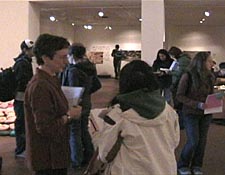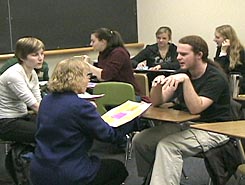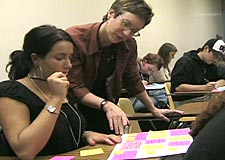INNOVATIVE TEACHING SHOWCASE
Writing about Visual Culture
Teaching Philosophy and Overview: Writing as a Way of Thinking
Writing can be a vehicle for students to explore their thought processes and the development of their ideas. It also provides a way to think through someone else's argument, whether it's read from a text or taken from a real-life context. As an educator working in the field of visual culture studies and art history in higher education, my goal is to help students learn to use writing to achieve a variety of objectives:

- to analyze the visual culture that surrounds them and that permeates other cultures
- to find meaning in course readings, which they can then apply to their own interpretations of visual culture
- to articulate their views on specific topics that interest them
The critical thinking inspired by writing improves class discussion, and makes for more meaningful class presentations and research-paper writing. My ultimate goal is to help prepare students for life after college. No matter which career they choose, they will need to be able to express their ideas clearly and find strategies for developing that clarity. Writing can provide a path to clarity in developing ideas, as well as offer a medium through which to present a finished product, be it a memo, budget report, artist's statement, grant proposal, or research project.
Integrating Writing into the Classroom
I teach a variety of classes that employ writing as a learning tool. For example, some of my introductory-level surveys include online discussions for which students "become" museum registrars in order to engage in problem-solving. Working with Writing Center assistants who facilitate discussions, students brainstorm solutions to museum quandaries. Problems have included determining which objects at the National Museum in New Delhi to transport to safety in the case of an impending natural disaster or choosing the best objects for a lecture on visual representations of Chinese philosophies. These online postings are "low-stakes" assignments through which students earn points for simply posting rather than for correctly applying grammatical or formatting conventions. These scenarios give students opportunities to see the ways in which their classroom studies could be applied in "real-world" settings.

My intermediate-level courses include blogging assignments and essay exams, which require different kinds of writing. The blogging assignment, like the online discussion board, is an informal style of writing; it is designed to give the students a place--and credit--for working out their ideas about readings before coming to class. I have found that this is a highly effective way to boost classroom discussion and enthusiasm for the topics introduced in the readings. The other type of writing I use most often at that level is the essay exam which gives students a chance to expand upon the writing they did for the blogging assignment in a "high-stakes" context. Thus, the low-stakes blogs become a staging ground for more refined thought and writing.

In my course Traditions and Transformation: Art and Visual Culture in Japan (see A/HI 371 syllabus), students weave their own "yarns" within the contexts of newly-learned aspects of Japanese art history and visual culture. This assignment provides a way for them to address their specific interests within Japanese visual culture through research completed to build the contexts for their stories. They are also able to continue their experiments with writing. For example, they gained first-hand knowledge of the rhythms punctuation provides for accentuating dramatic moments, which, coming back to the art historical setting, provides a useful parallel for thinking about ways in which visual arts are employed.
In my advanced upper-division seminars, we read articles and analyze aspects of visual culture relevant to the particular focus of each class. I use various types of writing to encourage critical thinking and help students better articulate their ideas. These courses have included blogging assignments, group writing projects, and hands-on writing applications in which writing serves an actual purpose in the world outside of the classroom.

As students have become increasingly concerned about having "real-world" experiences, I have become more focused on creating opportunities for authentic experiences that take students out of the classroom, especially in my senior-level classes. For example, working with Dr. Sarah Clark-Langager, director of Western Washington University's Western Gallery, my Art History 490 class, Exhibition Theory and Practice (see A/HI 490 syllabus), creates exhibitions that incorporate works from the Al and Vera Leese Collection gifted to Western by their daughter, Mrs. Marian Boylan. Students help with every aspect of the installations, from designing the lighting to hanging the prints and paintings with Western Gallery preparator Paul Brower. They also research and write all of the wall text that introduces the works in the exhibition to the public, each student focusing on two works. Students not only get a chance to experience how an exhibition is put together, but also become starkly aware—in becoming so deeply involved with the artists through research and through trying to communicate significant aspects of the works in the wall texts—how meaningful written language can be in terms of engaging an audience and creating a chance for public dialogue. (See student comments.)
Collaborating to Create a Culture of Writing

I continue to seek new ways of incorporating writing into the classroom and staying current with the constantly changing culture of education. My efforts to adjust my practices to make for more effective classroom environments and more enduring experiences for students are supported by a network of individuals and programs on Western Washington University's campus. Roberta Kjesrud, coordinator of the Writing Center, now called the Research-Writing Studio, at WWU, has encouraged me to experiment with new techniques for integrating writing into the classroom since I arrived at WWU in the fall of 2003. Her presence in my classes, directing workshops on themes such as choosing research paper topics and organizing ideas in preparation for writing, prompts students' interest in and success at writing. My colleagues in the Art Department have also been supportive of my classroom writing-assignment experimentations; their enthusiasm has buoyed my interest in continuing to explore new pedagogies and practices.
One of my most inspiring experiences as a teacher of writing has been working with Dr. Carmen Werder and other faculty as a Writing Fellow in 2006-07. Faculty from across campus gathered periodically throughout the year to discuss their evolving practices with regard to teaching writing. We shared assignments we were in the process of molding and experiences communicating with students about writing. We also examined how various pedagogical theories, such as "writing to learn" and the role of metacognitive understanding in the learning process, actually play out in the classroom and how they can benefit students. The 2007-08 Writing Fellows program, in which I am also participating, focuses on teacher-student collaborations in research. Art history major Robyn Rossmeisl and I are investigating the impact of blogging assignments on interactions in the classroom.

Opening classrooms to a variety of types of writing offers so many benefits to students:
- it gives them a place to work out their ideas
- it allows them the space to gather their thoughts before engaging in discussion, which can be intimidating to some students
- it gives them the hands-on experience of seeing the "real-world" value of learning to write effectively and being capable of creating a polished, finished product
Indeed, it is not an exaggeration to say that increasing the focus on writing at the college level increases the possibility of a more conscientious, proactive, and lucid citizenry. At WWU, learning to write as a way of thinking—a way of knowing—is acknowledged as an important feature of undergraduate education and I am glad to be a part of that effort.
↑ Go to top



